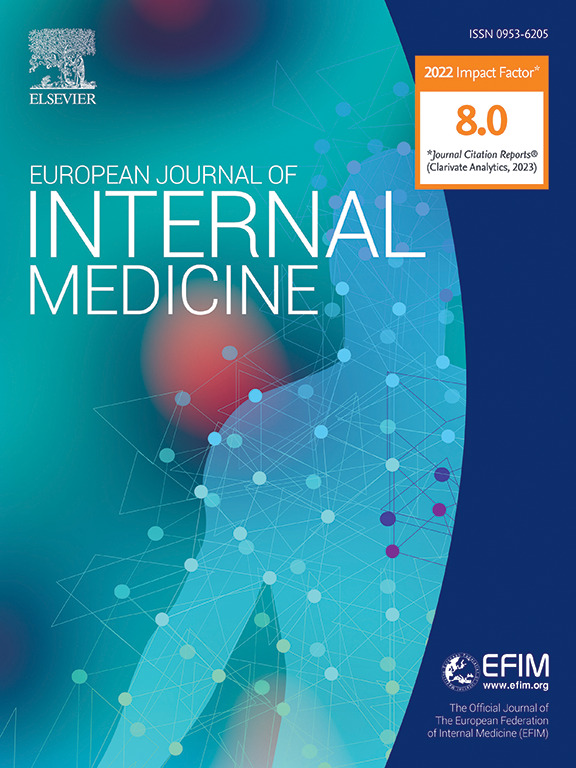Performance and costs of rule-out protocols for acute aortic syndromes: analysis of pooled prospective cohorts
IF 5.9
2区 医学
Q1 MEDICINE, GENERAL & INTERNAL
引用次数: 0
Abstract
Background
Acute aortic syndromes (AAS) are deadly conditions causing unspecific symptoms, such as chest/abdominal/back pain, syncope and neurological deficit. They are diagnosed with computed tomography angiography (CTA), but the patient selection is challenging. To support physicians and standardize management, protocols combining a clinical score with D-dimer (DD) have been developed. However, direct comparison of their diagnostic performance and cost-effectiveness is lacking.
Methods
We used individual patient data from 3 prospective diagnostic studies of patients with suspected AAS, enrolled in 12 centers from 5 countries. Diagnostic accuracy, failure rate and costs were calculated for 5 protocols, applying 3 scores (aortic dissection detection [ADD], AORTAs and Canadian) and 2 DD thresholds (500 ng/mL [DD500], age-adjusted [DDage]). Costs were estimated using Italian and German reimbursements.
Results
Among 4907 patients, 506 (10.3 %) had an AAS. The sensitivity of the diagnostic protocols ranged from 97.6 % for Canadian/DD500 to 99.4 % for AORTAs/DD500 or DDage (P = 0.022). The specificity was lowest for AORTAs/DD500 (46.8 %; P < 0.001 vs AORTAs/DD500) and highest for ADD/DDage (61.5 %; P < 0.001). The number of potential AAS misses was 4-fold higher with Canadian/DD500 vs AORTAs/DD500 or DDage. The net clinical benefit was highest for ADD/DDage. All protocols reduced CTA exams and costs over a CTA-to-all strategy. Numbers of predicted CTA exams and costs per 100 patients were lowest for ADD/DDage (447 CTAs, 34,366 EUR) and highest (579 CTAs, 43,628 EUR) for AORTAs/DD500.
Conclusions
Guideline-compliant clinical score/DD based protocols are highly sensitive. Differences in specificity and efficiency are present. Data may guide decision-making based on policies and resources.
急性主动脉综合征排除方案的性能和成本:汇总前瞻性队列分析。
背景:急性主动脉综合征(AAS)是一种致死性疾病,可引起非特异性症状,如胸/腹/背疼痛、晕厥和神经功能障碍。他们被诊断为计算机断层血管造影(CTA),但患者的选择是具有挑战性的。为了支持医生和规范管理,已经制定了将临床评分与d -二聚体(DD)相结合的方案。然而,缺乏对其诊断性能和成本效益的直接比较。方法:我们使用来自5个国家12个中心的疑似AAS患者的3项前瞻性诊断研究的个体患者数据。采用3个评分(主动脉夹层检测[ADD]、AORTAs和Canadian)和2个DD阈值(500 ng/mL [DD500]、年龄调整[DDage])计算5种方案的诊断准确率、失败率和成本。费用是用意大利和德国的偿还额估计的。结果:4907例患者中,506例(10.3%)发生AAS。诊断方案的敏感性从Canadian/DD500的97.6%到AORTAs/DD500或DDage的99.4% (P = 0.022)。主动脉/DD500的特异性最低(46.8%;P < 0.001 vs主动脉/DD500), ADD/DDage最高(61.5%;P < 0.001)。与主动脉/DD500或DDage相比,加拿大/DD500的潜在AAS漏诊数高出4倍。ADD/DDage的临床净收益最高。所有协议都减少了CTA检查和CTA对所有策略的成本。预测的CTA检查数量和每100名患者的费用,ADD/DDage组最低(447例CTA, 34,366欧元),aorta /DD500组最高(579例CTA, 43,628欧元)。结论:符合指南的临床评分/DD方案是高度敏感的。特异性和有效性存在差异。数据可以指导基于政策和资源的决策。
本文章由计算机程序翻译,如有差异,请以英文原文为准。
求助全文
约1分钟内获得全文
求助全文
来源期刊
CiteScore
9.60
自引率
6.20%
发文量
364
审稿时长
20 days
期刊介绍:
The European Journal of Internal Medicine serves as the official journal of the European Federation of Internal Medicine and is the primary scientific reference for European academic and non-academic internists. It is dedicated to advancing science and practice in internal medicine across Europe. The journal publishes original articles, editorials, reviews, internal medicine flashcards, and other relevant information in the field. Both translational medicine and clinical studies are emphasized. EJIM aspires to be a leading platform for excellent clinical studies, with a focus on enhancing the quality of healthcare in European hospitals.

 求助内容:
求助内容: 应助结果提醒方式:
应助结果提醒方式:


